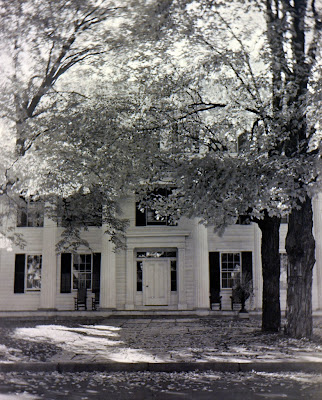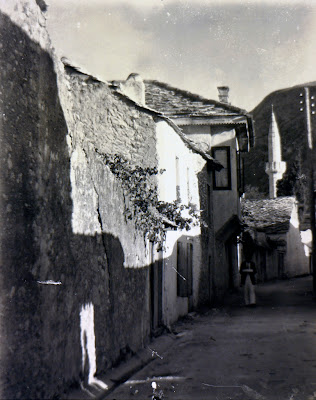I. My parents bought a print of White Birches In Vermont when we lived in Massachusetts and, years later, it moved with me when I left home. I liked the picture simply for its reminder of New England. The name of the artist, Luigi Lucioni, meant nothing to me; it never came up in any of my art history classes. Then I spent several winter vacations in Manchester, Vermont. After my first visit there, I began to have an odd feeling about that picture hanging in the dining room at home.
I had seen that golf course and those birches blanketed in snow, from the kitchen window on a old house by the side of the main street in Manchester. The white spire belongs to the Congregational Church on the Village Green. The old Eaton House is out of Lucioni's line of sight, hidden by the trees. Lucioni wisely chose the most picturesque angle for a scene that he would revisit several times in paint, ink, and dry-point. In the background Mt. Equinox looms, the tallest mountain in southern Vermont, and named for the auspicious date when Vermont's Surveyor General reached its peak in 1823,. Mount Equinox shadows old U.S. Route 7, on its northward way from Norwalk, Connecticut to the Canadian border. This once revolutionary road was home to "the most rebellious race on the continent", according to an outraged British General John Burgoyne in 1777.
When I was there, across the road from the Eaton House stood the remains of the Equinox Hotel, its peeling white clapboards and rotting Corinthian columns flickered in the headlights of passing cars heading north from New York in search of good snow-pack. Begun as a private home, the Equinox Hotel opened in to the public in 1853 to serve a clientele of wealthy city residents from cities seeking relief from the summer heat. The Equinox welcomed four Presidents, but not Abraham Lincoln whose wife Mary Todd Lincoln had booked a suite for the summer of 1865. Exactly forty years later their son Robert Todd Lincoln would return Manchester to build himself a permanent summer home.
Times change, not once but again and again. The Equinox closed in 1972, a victim of air-conditioning and the changing tastes of vacationers. By the time I first saw it, the Equinox was thought to be too dangerous to enter and beyond of hope of repair. Then an improbably poetic rescuer appeared by the name of Perrier- Jouet & Cie. The pure spring waters that ran off the mountain had been bottled and sold by the Equinox Water Company from the 1880s to the 1920s. There was even a ginger champagne!
Once I recognized where the white birches were, I had to come back in summertime. Then I discovered the marble sidewalks (four miles of them), the pride of the village, all the stone quarried locally and scrubbed carefully each spring to remove any traces left by acid rain.
Clara Sipprell - The Ekwanok Golf Course In Manchester - undated.
This photograph was taken in the afternoon, facing east from behind the Eaton house.
Clara Sipprell - Congregational Church in Manchester, Vermont - ? before 1960.
Next door to the north (left) of the church is the Eaton house. Note the white marble sidewalks.
Clara Sipprell - untitled, c.1940-50
This building is located north of the Eaton house and is part of the Equinox complex. It was an abandoned ice cream shop when I first saw it.
Clara Sipprell - The Equinox Hotel (a small part of the facade that stretches for an entire block), c. October, 1937.
This photo was taken in the afternoon on a day much like today.
II. Fast forward to the winter of 1993, as news from the Balkans provided a painful daily tutorial in geography. Alerted, I noticed a book Clara Sipprell: Pictorial Photographer by Mary Kennedy McCabe (Amon Carter Museum: 1990). Until then totally unknown to me, Sipprell was a photographer had traveled to the Balkans in the 1920s. My curiosity was piqued when I read that Sipprell's friend, the novelist Dorothy Canfield Fisher, who persuaded to make her summer home in Manchester, Vermont, from 1937 until she eventually moved there permanently. Somehow I was shadowing Clara Sipprell without even knowing who she was.
Clara Sipprell (1885-1975) was born in Tilsonburg, Ontario, the last child and only girl in a family of six. Her schoolteacher father, died before Clara was born, leaving the mother to support the family as best she could. One by one, the family migrated eastward to Buffalo, New York, where Clara's older brother Frank opened a photography studio. Sipprell Photography was auspiciously located at 795 Elmwood Avenue,
just down the street from the Albright-Knox Gallery where Alfred
Stieglitz chose to hold the first International Exposition of Pictorial Photography, in November, 1910. Clara began to hang around the studio so her brother gave her a Kodak and, in 1910, she exhibited her work at the Buffalo Camera Club, although it did not (yet) admit women. Five years later, sure of her vocation, Clara Sipprell left for New York.
Decades later, by then an accomplished photographer, Sipprell wrote that she was, “some kind of interpreter of humanity's eternal struggle to
know itself and its surroundings through an unswerving faithfulness to the
eternal truths.” It would be easy to explain Sipprell's neglect at the hands of art historians by her unfashionable views or her adherence to pictorialism decades after it had gone out of favor. But I wonder. Sipprell never married yet she was hardly an insipid old maid; she loved to drive fast cars and collected the traffic tickets to prove it, smoked, traveled widely and photographed famous personages from the sculptor Rodin to the Queen of Sweden. One recent (male) critic described her appearance in unflattering terms, as though that explained it and, for him, it did.
A tragic accident of history made Sipprell's work relevant once again. In her photographs we have access to another world in time where minarets and crosses coexist, where women, men, and children lead ordinary lives, and the land is old, not the enmities. And for all the times I travailed back and forth on Elmwood Avenue and all the times I have walked along the sugar-white marble sidewalks of Manchester, I would have loved to have Clara Sipprell as a companion, at least in my imagination. Better late than never but still too late, always too late.
A tragic accident of history made Sipprell's work relevant once again. In her photographs we have access to another world in time where minarets and crosses coexist, where women, men, and children lead ordinary lives, and the land is old, not the enmities. And for all the times I travailed back and forth on Elmwood Avenue and all the times I have walked along the sugar-white marble sidewalks of Manchester, I would have loved to have Clara Sipprell as a companion, at least in my imagination. Better late than never but still too late, always too late.
Clara Sipprell - The Harbor At Split, Dalmatia, c. 1926.
Clara Sipprell - A Street In Kotor, Dalmatia, 1926.
Clara Siprrell - A Street In Old Mostar, c. 1926.
Clara Sipprell - A Mosque In Mostar, c. 1926
Clara Sipprell - Woman Sitting on A Cobblestone Street, Montenegro, 1926.
Clara Siprrell - Marketplace in Zagreb, c. 1926.
Clara Sipprell - A Street Shrine In Kotor Montenegri, 1926.
Clara Sipprelll - A Moslem Woman In Sarajevo Bosnia, c.1926.
Clara Sipprell - A Little Turkish Girl, c.1926.
Clara Sipprell - A Shoemaker in Sarajevo, c.1926
For further reading:
Clara Sipprell: Pictorialist Photographer by Mary Kennedy McCabe, Fort Worth, Amon Carter Museum: 1990.
Images:
Luigi Lucioni - White Birches In (Manchester) Vermont.
Clara Sipprell - photographs from the collection of the Amon Carter Museum, Fort Worth.
















5 comments:
Peinture à remonter le temps et les yeux dans les yeux d'une photographe : ce billet a quelque chose de proustien, chère Jane, et il me touche.
Tania, I think that Sipprell's loyalty to the pictorialist style is what gives her pictures that quality you describe.
These are lovely photos but I beg to differ that they are all "Pictorialist". I would say that perhaps some of the earlier photos are, but Sipprell moved on to a more modern style later. This was an evolution that happened to both Steichen and Weston who moved on from the ethereal world of pictorialism to a more dramatic modern style with more of an emphasis on dramatic contrasts that the B&W photo medium was capable of. The topics were similar to those of the Pictorialists, but lack the gauzy tones, manipulated backgrounds and cloud effects and dreamy, painterly quality that characterizes the Pictorial tradition.
welcome, Margaret. Thanks for your comments. I think you are right about this. I found something so romantic about Manchester, Vermont, I suppose. There were many times that we passed by what was Clara Sipprell's house there but I didn't know who she was at the time. To think that I might have seen her and not known who she wss makes me sad.
It is impossible to see those birch trees from any kitchen window on main street. You are mistaken.
Post a Comment